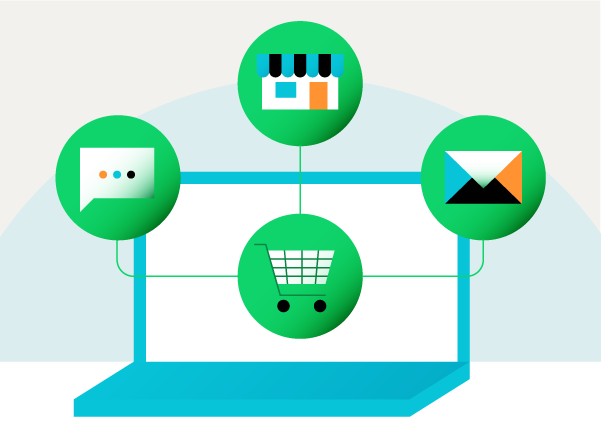In both traditional and ecommerce, each product or service moves through a supply chain. Some are very simple, while others are far more complex and require calculated coordination from distribution managers. Distribution management (or supply chain management) is the management of the movement of goods. As these goods evolve from raw materials at the beginning of the procurement cycle to finished products, distribution managers ensure every step is accounted for along the way.

Three ways your distribution management strategies are affecting your supply chain
What are the benefits of effective distribution management?
When supply chains are well-managed through distribution networks, companies save money on warehousing operations, streamline inventory management systems by forecasting, boost their production efficiency, and improve overall customer satisfaction by emphasizing fair pricing and quality delivery. Effective management results in fewer logistical headaches and a better product offering.
But an effective distribution management system doesn’t just focus on logistics. There are many things to consider when managing supply chain operational efficiency over a variety of industries. Planning for demand, supply, production, sales and operations, and material requirements are just a few of the things you need to consider for your distribution management operations.
Read on to learn a few of the ways your distribution management strategies are affecting your supply chain.
You’re not setting your prices based on markups and margins
Adjusting your pricing to focus on profit optimization is an important step to a healthy business model. Discrepancies within mock-up pricing and actual margins lead to businesses losing money across the supply chain.
QuickBooks Enterprise automatically updates prices to maintain a healthy markup to generate profits, even when your wholesale costs change. Automation helps you decrease human error and save time by creating rules based on your business’ specific needs. You also have the flexibility to set seasonal pricing for industry conditions.
Customer scenario: A midsized ceramics shop has been finding that their revenue lately hasn’t been enough to cover their expenses, such as the clay, powering the kiln, and social media marketing costs. By using QuickBooks, they can use automated pricing reports to set prices to ensure they’re turning a profit, even if the costs of clay fluctuates or the busy holiday season has ended.
You can’t look at the bigger picture
When you have an easily accessible hub to locate vendor and pricing information, you can quickly compare contracts and prices. In a warehouse management system, like that available through QuickBooks Enterprise, vendor information is fully centralized. Distribution managers can easily find pricing information, contact details, and item information whenever they need. They can also access information for alternate vendors if something falls through and they need a quick solution.
Batch-importing vendor information, such as pricing lists, can also save distribution teams time while reducing errors. Automation across the vendor ecosystem improves distribution management [JS1] by making it easy to see the big picture at a glance.
Customer scenario: A retailer with about a dozen boutiques across the country has been having trouble managing relationships with the smaller brands they carry in store. Communication around pricing hasn’t been very frequent, and the business owners are finding inconsistencies in pricing in various boutiques, which has frustrated customers. By incorporating QuickBooks Enterprise, the company can integrate all vendor and pricing information into one simple portal. Now pricing is consistent across the company, profits are realized at point of sale, and vendor relations are stronger than ever as stores bring in more and more smaller brands.
You’re not taking advantage of automated reporting capabilities
It’s hard to grow if you don’t have real-time data management processes to guide you toward tangible improvement. Gathering KPIs and insights is simple when you automate weekly reports to stay on top of your business’ profitability over time.
In QuickBooks Enterprise, you easily can view profitability for your business overall, and more granularly by profit by item. With the advantage of increased visibility, forecasting capabilities provide the closest thing we have to a crystal ball. You also have the option to customize your reports and notifications to the exact information your business needs to succeed as you sort by month, product, customer, or sales rep on your supply chain. QuickBooks Enterprise also provides access to inventory valuation summary reports and alternate vendor reports to enhance distribution management.
Customer scenario: A warehouse employing about 75 employees has been struggling to keep up with the inventory demands of their customers. Unfortunately, they haven’t been able to pinpoint exactly what step in the supply chain needs improvement. Since they’re a medium-sized company, they can’t simply employ some of the same techniques that giants like Amazon have the capabilities and capital to utilize. They decide to use QuickBooks Enterprise to begin pulling weekly automated reports on KPIs like monthly sales, popular products, what industry-specific sales are increasing month over month, and which sales staff are increasing their numbers. These insights are providing the warehouse with tangible guidance on how they can improve their distribution management[JS2] .
See how QuickBooks Enterprise can help you optimize your supply chain operations
There are many ways you can ensure your supply chain is functioning at full capacity. QuickBooks Enterprise puts these techniques within reach by giving you the power to improve your distribution management practices. Discover how QuickBooks Enterprise can support your distribution management strategy.










